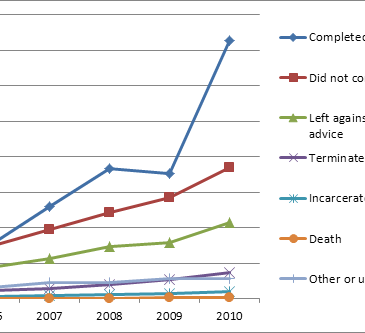Editor’s Note: Kelly Abrams Johnson is a special contributor to The BASIS and is a graduate student in the Department of Health Education and Promotion at East Carolina University. Dr. Ryan Martin served as a guest editor. Dr. Martin, formerly of the Division on Addiction, is now Assistant Professor in the Department of Health Education and Promotion at East Carolina University.
During the past decade, there has been a significant increase in maternal opioid abuse and neonatal abstinence syndrome (Pan & Yi, 2013; Patrick et al., 2012). However, researchers have not examined how these changes have impacted opioid treatment admissions among pregnant women. This week’s STASH reviews a study of recent (1992-2010) trends in treatment admissions for prescription opioid abuse during pregnancy (Martin, Longinaker, & Terplan, 2015), as part of our Special Series on Motherhood and Addiction.
Methods
- This study used Treatment Episodes Data Set-Admissions (TEDS-A) from 1992 to 2010 to examine:
- The prevalence of prescription opioid abuse admissions among pregnant women.
- Changes in demographic, substance abuse, and treatment characteristics among these admissions over time (i.e. how those admitted for treatment differ in terms of age, race, housing, and other characteristics over time).
- In addition, researchers used the Treatment Episodes Data-Discharges (TEDS-D) to determine the reason for discharge, and to describe changes in additional treatment characteristics, including:
- Treatment completion status.
- Reason for discharge (i.e. leaving against professional advice, termination, incarceration, death).
Results
- From 1992 to 2012, among admissions for pregnant women, those reporting prescription opioid abuse increased from 2% to 28%.
- Researchers found significantly higher admission rates among the following groups of pregnant women:
- Women aged 21-29 years
- White non-Hispanic
- Unmarried
- Had received, at minimum, a high school diploma
- Unemployed
- Had housing
- Women who reported having a co-morbid psychiatric illness
- Living in the South
- The treatment completion status among patients discharged for prescription opioid treatment from 2006 to 2010 is shown in Figure 1.
- Overall, more than half of the pregnant women admitted for prescription opioid treatment completed treatment.
- Among those who did not complete treatment, the majority were either terminated by the facility due to non-compliance or rule violations, or left against professional advice.
Figure. Treatment completion status of prescription opioid treatment discharges among pregnant women, TEDS-D 2006-2010 (adapted from Martin, et al., 2015). Note. Categories including left against professional advice, terminated by facility, incarcerated, death, other or unknown, are subsets of the category “did not complete.”. Click image to enlarge.
Limitations
- Martin et al. (2015) reported possible bias of their sample due to the exclusion of private facilities. Therefore, their sample is not representative of all prescription opioid abuse treatment admissions among pregnant women over time.
- TEDS-A counts every admission and readmission as a separate episode, thus limiting the ability of researchers to check the treatment progress of individuals over the course of their treatment and potentially counting the same person twice.
Conclusion
Opioid abuse among women of reproductive age continues to increase; therefore, it is important to identify risk factors and target prevention and intervention programs toward those most at-risk. Doing so could increase the utilization of medication-assisted therapies to improve maternal medical status, and decrease fetal morbidity. Further research is needed to provide a better understanding of why some pregnant women are at a higher risk than others at the local, regional, and national levels.
— Kelly Abrams Johnson
What do you think? Please use the comment link below to provide feedback on this article.
References
Martin, C.E., Longinaker, N., & Terplan, M. (2015). Recent trends in treatment admissions for prescription opioid abuse during pregnancy. Journal of Substance Abuse Treatment. 48(1), 37-42.
Pan, I. J., & Yi, H.Y. (2013). Prevalence of hospitalized live births affected by alcohol and drugs and parturient women diagnosed with substance abuse at liveborn delivery: United States, 1999-2008. Maternal and Child Health Journal, 17(4), 667-676.
Patrick, S.W., Schumacher, R.E., Benneyworth, B.D., Krans, E.E., McAllister, J.M., & Davis, M.M. (2012). Neonatal abstinence syndrome and associated health care expenditures: United States, 2000-2009. JAMA: The Journal of the American Medical Association, 307(18), 1934-1940.





